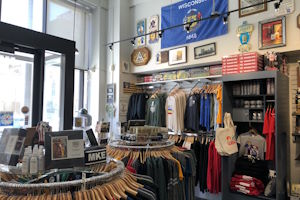Classical
Various Artists
By Nikki Butgereit Anchored In Love: A Tribute to June Carter Cash is the musical counterpart to John Carter’s biography of his mother. Clearly, this album was a labor of love, not just for the grieving son, but for the artists and relatives who came together to celebrate Carter Cash’s musical legacy. The album opens with Sheryl Crow and Willie Nelson’s duet of “If I Were a Carpenter.” The song evokes June’s relationship with Johnny Cash, and the contrast between the older and younger artists throughout reinforces the tone of the album – today’s country music principals honoring the music of the past. To that end, Brad Paisley sheds all traces of modern country on his cover of “Keep On The Sunny Side.” The plucky banjo and lilting vocals of The Peasall Sisters and Billy Bob Thornton’s husky spoken word on “Road to Kaintuck” form just the right juxtaposition to elicit memories of an old-time radio show. But the album’s standout track is Elvis Costello’s slowed-down version of “Ring of Fire,” which removes all of the gritty urgency of Johnny Cash’s version and turns the song back into a true ballad. The inclusion of “Will the Circle Be Unbroken” reinforces the strong impact that June Carter Cash and her family had on folk and country music. The songs are classic, and the lyrics and melodies as quaint as they are strong, much like the woman herself. The Carter family’s footprint on the landscape of modern country is large and deep, and Anchored In Love is a fitting tribute to an influential voice. VS
Jun 1st, 2007 by Vital ArchivesBlack Strobe
By Ally Berndt Norwegian death metal. Gothic French electro. ‘80s electronic body music. Something totally different. Any or all of the above can be ways used to describe Black Strobe. Burn Your Own Church – “Brenn Di Ega Kjerke” in Norwegian – is Black Strobe’s latest album, and while all 11 tracks reflect the group’s Depeche Mode and ‘80s rock influences, most also represent a darker, trance-like mood. The sound is good, but probably best appreciated if you’re hopped up at a Euro rave. “Blood Shot Eyes” is a quirky song that’s mixed well and puts the synthesizer to great use, yet sounds oddly reminiscent of the Super Mario Brothers theme if set against Norwegian metal. Included on the album is a cover of Bo Diddly’s “I’m a Man.” It’s bluesy but more hyped up – a little bit out there, but enjoyable nonetheless. And if Rammstein put together an ‘80s house mix, I’m pretty sure it would sound very much like “Not What I Need,” with its deep half-spoken lyrics in Euro-metal drag. The last two tracks – “Last Club on Earth” and “Crave for Speed” – are by far the best, featuring not only the strongest vocals, but also some great piano work. It’s a welcome switch from synth and showcases Black Strobe’s low-key side. Burn Your Own Church is a decent album with a lot of great production work; the mixes are actually the best part. There could’ve been a little more guitar and a little less of the often over-powering keyboards and synthesizers, but overall Black Strobe has put together a well-rounded record that pulls elements from many styles of music and then lays them over acid-infused beats. Americans should definitely check it out, if only for the fact that it’s just not your everyday electro mix. VS
Jun 1st, 2007 by Vital ArchivesThe Sea and Cake
Since their debut in 1993, Chicago’s The Sea and Cake have quietly grown into hometown favorites alongside Tortoise, creating pop that’s one part ambient, one part jazz, one part rock and all parts pure. This unique sound, anchored by guitarist Sam Prekop’s trademark wispy-as-clouds vocals, has evolved from notional indie pop into this consistently eclectic mixture since their first electronic dabblings on the 1997 album, The Fawn. Flash forward to the new millennium. 2003’s One Bedroom, which perfected jazzy indie-tronica, was adored by fans who were left to hang thereafter with a band hiatus. Thus, their newest, Everybody, is not only welcomed personally by fans who have longed to hold another Sea and Cake concoction in their hands, but also in general, because the band is showing their ability to grow without completely abandoning their sound circa 1997-2003. With Everybody, the band builds on past musical success by boomeranging back to their roots and catching some of the fundamental aspects that first garnered it attention. Perhaps this was possible due to the help of producer Brian Paulson (Slint, Wilco) who took the reins so the band could concentrate fully in the studio (drummer John McEntire previously did all the band’s production work). Outlining the songs with the organic elements of a true rock outfit such as fuzzed-out guitars ( “Crossing Line” ), clean beat-keeping drums ( “Middlenight” ), filling in the lines with the pretty-as-bells guitars of Prekop and Archer Prewitt and then mixing it up with subtle syncopation and glossing it over with Prekop’s melody-challenged but soothing voice, The Sea and Cake take us back to their beginning. McEntire and Erik Claridge (bass) still manage to add the signature noodling ( “Exact to Me, “Left On” ) that makes this band sound so much like…well… themselves. Everybody hits that gratifying sweet spot. It’s got enough ‘oomph’ not to wimp out yet retains the subtle jazzy elements that will make this album one of the most delicious slices of pop baked goods to satisfy fans in years. VS
Jun 1st, 2007 by Erin WolfGreat Lakes Myth Society
“Girlfriends are leaving/new girls arrive/you open the circle/to be blinded by light.” This lyric from “Heydays,” the opening track to Compass Rose Bouquet, the sophomore offering from Michigan “northern rock” music “collective” Great Lakes Myth Society, perfectly summarizes the thesis being defended throughout – melancholy is meaningless unless it’s tempered by good spirits in the heart and in hand. When guitarist Timothy Monger sings “Uncertain the future/nostalgic the past/unable to recognize/moments that last,” there’s more sun in his voice than rain. That springtime disposition carries into all aspects, from production to songwriting. The tunes crackle with energy and spark, from the cavernous drums to the silvery trumpets on the psychedelic-via-”Crimson-and-Clover” tune “Raindrops and Roses.” The band isn’t afraid to explore the myriad folk influences available to their collective, either; “Queen of the Barley Fool” and “Debutante” incorporate Irish pub choruses without slipping into affectation. “Debutante” even throws indie-rock distortion into the guitars, giving the up-tempo jig some teeth. They accompany accordion-driven waltz “The Gales of 1838,” which closes the record with a slow, six-minute build that sways like the bow of a wind-blown pirate ship complete with refrains proclaiming that we’ll have “wine, wine, wine, more wine tonight.” This is Americana anyone can get behind. Great Lakes Myth Society takes the folk-infused sound with which we’ve all become intimately familiar and polish it with a pop sheen, producing earthy, heartfelt waltzes and jigs that manage to be introspective and fun at the same time. Pass the Jameson; who wouldn’t drink to that?
Jun 1st, 2007 by DJ HostettlerJune 2007
June 5th The Aggrolites Reggae Hit L.A. Hellcat/Epitaph Belly The Revolution CP Marilyn Manson Eat Me, Drink Me Nothing/Interscope Paul McCartney Memory Almost Full Hear Music/Concord O.A.R. Life From Madison Square Garden Atlantic Rihanna Good Girl Gone Bad Def Jam Bruce Springsteen Bruce Springsteen With the Seeger Sessions Band Live in Dublin Columbia Swizz Beatz One Man Band Universal Motown Tiger Army Music From Regions Beyond Hellcat/Epitaph Various Artists We All Love Ella: Celebrating the First Lady Of Song Verve June 12th John Doe A Year in the Wilderness Yep Roc The Mission, U.K. God is a Bullet Cooking Vinyl Sinéad O’Connor Theology Koch Mark Olson The Salvation Blues HackTone Queens of the Stone Age Era Vulgaris Interscope Mark Ronson Version RCA June 19th The Chemical Brothers We Are the Night Astralwerks Maps We Can Create Mute The Mooney Suzuki Have Mercy Elixia The Polyphonic Spree The Fragile Army TVT Two Gallants The Scenery of Farewell Saddle Creek The Unseen Internal Salvation Hellcat/Epitpah Matt White Do You Believe Geffen The White Stripes Icky Thump Third Man/Warner June 26th Ryan Adams Easy Tiger Lost Highway The Automatic, Automatic Not Accepted Anywhere Columbia Bad Brains Build a Nation Megaforce Beastie Boys The Mix-Up Capitol Marc Broussard S.O.S.: Save Our Soul Vanguard The Click Five Modern Minds and Pastimes Lava/Atlantic Editors An End Has a Start Kitchenware Nick Lowe At My Age Yep Roc Meat Puppets Rise to Your Knees Anodyne M.I.A. Kala Interscope Mya Liberation Motown Steve Vai Sound Theories Vols. 1 & 2 Epic
Jun 1st, 2007 by Erin WolfColin Hay, May 3 @ The Miramar Theatre
By Erin Landry Dropping in at Bay View’s local watering hole, the Palomino, you might have had the pleasure to be served a drink by Colin Hay’s opening act Thursday night: the talented Davey von Bohlen (of Cap’n Jazz, Promise Ring and Vermont fame), a regal name he says that was given to him at birth, which after the first few songs you realize is in direct contrast to his humble disposition. Starting off a set with “songs that preamble” by his own admission, he covered material from his “younger days” as well as songs recorded by his current band, Maritime. His voice warbles then cracks at one point, he misses notes, he stops then starts when he forgets lyrics, he laughs and chides himself, all of which just add to the spontaneous feel of his music. The imperfections and mistakes, instead of being distracting, conveyed the creative process and created an intimate performance. It was less of a concert, more of an impromptu experimental venture, music in its most raw form. And, though no explanation was necessary, after a youthful chirp from his two-year-old at the back of the crowd, he confesses that instead of practicing before the show, he “slacked off” and took his son to the children’s museum. How can you not forgive that? During intermission, the ladies room titters with rumors that Colin Hay’s live performances include his wife who does interpretive dance. Back inside the theatre, the lights dim and a rousing backstage introduction, which sets the tone for the rest of the night, describes Colin as a multi-platinum performer who “believes football is played with a round ball, enjoys sunsets, walks on the beach, and ladies, if you’re wondering, he’s a cancer.” Let’s get this right out of the way; Colin Hay is so much more than a blip on the ‘80s pop icon MTV screen (Men at Work). Since that time he has assembled an enviable body of work that has been touted through television via “Scrubs” and film via the indie hit “Garden State.” He is an artist that withstands the changing times, providing a new body of work of evocative and bittersweet songs and contemplations on life. In any case, the night’s performance is less pop concert more all-inclusive variety show (in the best possible sense) with song, poetry, comedy, storytelling and, true to rumor, an array of vocals, kazoo playing and interpretive dance by his gorgeous wife, Cecilia. The first hour was a sprinkling of newer songs overshadowed mostly by Mr. Hay talking about youth, life lessons and other musings including an admission that, while he recently wrote a song about the infamous Bob Dylan (his opening song: What Would Bob Do?), he’s never actually met the man in person. But instead of working on an album or song with Dylan, he says how he’d prefer to work on a car together, talk about alternators and transmissions…or maybe walk around a Costco in search for toilet paper, all the while […]
May 7th, 2007 by Vital ArchivesAqualung, May 3 @ The Pabst
Photo by CJ Foeckler/Pabst Theater It’s difficult to write a music review these days without drawing an inevitable comparison to a predecessor or contemporary. The case in evidence: Matt Hales’ Aqualung, which took the stage Thursday night as part of the Milwaukee Pabst Theater’s fairly priced series of talented but mostly underground and underrated national acts. What’s important about mentioning this last part has to due with some intimacy issues in the venue, which will come up again later. Matt Hales appears to be in his early 20s, which is probably important in light of the recent new flood of Britpop artists who have given us boatloads of sensitive rock in the past few years. If we follow a family tree, then Blur begat Verve and Suede, who begat Oasis and Radiohead, who begat Coldplay and Travis, which gave us (and drawing the wannabe label) Aqualung…and Keane, James Blunt, Snow Patrol, the Feeling, and…well, just insert your own VH1 You Oughta Know find – where Hales got his first American-side break. But the 35-year-old piano rock singer/songwriter is a bit older than most on the tree, and did not find success until landing a successful tune for the new Volkswagen Beetle in 2002. It’s hard to quantify a sound when in the middle of it. When synthpop was at its height, did music fans say, “Oh, that Erasure. They’re just a Depeche Mode wannabe.” At the time, there was room for everybody. Shouldn’t it be fair to just claim Aqualung as an overall part of a new movement deeply entrenched in mood and angst? Hales does not make it easy. To sit back in the demure and refined darkness of the Pabst and enjoy his obvious and highly-trained musical talent, there has to be a suspension of disbelief. This would mean in musical terms that the audience member would forgive the lapse in organic flow and just be entertained. But just close your eyes as the four-piece band plays, and suddenly you’re listening to the sound of Ben Folds. Then in another song, Chris Martin. Then another, Damon Albarn. Another, Thom Yorke. The music eloquently meanders like this as you try and guess the influence, like a gourmand attempting to guess the subtle flavors as they emerge in a complex dish. When Aqualung launches into “Pressure Suit,” off his newest studio album Memory Man, suddenly you are hearing Jeff Tweedy and Wilco circa A Ghost is Born. Hales goes so far as to admit a personal infatuation with the band during one of his cheeky bantering with the audience. From there, Hales (now seated at a baby grand instead of standing up front at a Yamaha keyboard) and company attempt to cover Wilco’s “Muzzle of Bees.” “Attempt” is used as the operative word here since it seems like something the guys rehearsed on the tour bus ride into town. Also, the lowdown desperation of Tweedy’s version is missing and replaced with something more harmonious. To his credit, Hales voice often […]
May 4th, 2007 by Brian JacobsonA little bit indie, a little bit classical
Photo by Lenny Gilmore They may have a cute name, cute merch and cute alternating boy/girl vocals, but the nine-month-old Kid, You’ll Move Mountains aren’t aiming to charm, though frontman Jim Hanke does admit the five-piece has had “great luck fall in [their] lap.” This luxury has allowed a somewhat lax approach to promotion and recording – but don’t think the band lacks a smidge of motivation or enthusiasm. “Our ages and personal situations require us to be pretty focused,” says drummer Nate Lanthrum, with a subtle air of experience. From 2001 to 2005, Lanthrum and his brother, bassist Andrew, toured six months a year with Chicago’s Troubled Hubble, as Hanke sang for El Oso across the northerly state line. Ultimately, it was Hubble’s showcase for Latest Flame Records in Hanke’s hometown of Milwaukee that crossed the musicians’ paths. After being “blown away” by their performance and “overall humility,” Hanke and Lanthrum’s bands formed a “family-like union,” booking and networking together throughout the Midwest. As both projects wound down from current to former, Hanke and the Lanthrums, still eager to “bring something new and creative to [their] respective local scenes,” appended guitarist Corey Wills and classically trained pianist Nina Jones – whose background contributes a more traditional perspective – to complete the group. “Nina is a phenomenal musician,” says Lanthrum, in awe of Jones’s comprehension of “notes and keys” instead of his more-familiar “deep, guttural sounds and sweeping arm gestures.” Nevertheless, he’s learning, and is convinced that with her dynamic, KYMM has “a whole new range of places to go.” In August of 2006, the band was in the downtown WMSE studio playing a set for the Local/Live program. “We weren’t sure that having a radio show as our documented first recording was the best idea, but the sound was perfect for what we were looking for,” Lanthrum says of the convenient, minimal production. Hanke adds, “It was a good opportunity to record our first six songs together for nothing.” Further boosting the grassroots appeal of the EP, a Polaroid photo taken the day of purchase satisfies both the need for album art and a “slightly different” execution. At live shows, the instant camera is omnipresent and fans can opt to be photographed for their own CD jacket. “The only downside,” says Hanke, is “when people refuse the picture because they think they look pudgy or they have red eye. We have a stack of those.” Clearly, photo discards should be incorporated into the packaging of KYMM’s upcoming glossy debut, which the band is currently in the process of home recording, somewhere between Milwaukee and Geneva, Illinois. “We definitely want to get an official record out there, but we are also anxious to take our time and tool around with different ideas and make the entire process a fun adventure,” says Hanke. In the meantime, Hanke intends to “play as many shows as possible” as Lanthrum scratches his itch to return to the road. KYMM has already opened for a […]
May 2nd, 2007 by Amber HerzogBright Eyes
Polarizing indie icon Conor Oberst lobs his first full-length studio album since 2005’s simultaneous releases I’m Wide Awake, It’s Morning and Digital Ash in a Digital Urn. Cassadaga, Florida, renowned “Psychic Center of the World” and the “South’s Oldest Spiritualist Community,” is the CD’s namesake. Songs about self-cleansing, balancing out and finding home emphasize the spiritual theme. “Four Winds” – on loan from this spring’s eponymous EP – and the Janet Weiss-drummed “Hot Knives” come as close as Americana can get to head-banging and fist-pumping. “Middleman” flaunts Iron & Wine-worthy breaths of grainy fiddling and “I Must Belong Somewhere” alone embodies enough colorful imagery to defend Oberst’s visionary status. Tribal beats and vocals feel fresh on the atmospheric “Coat Check Dream Song.” “Make A Plan To Love Me” begins as an airy lullaby swirled with female a capella, but becomes so over-produced that it winds up leaning toward theatrical score. Though delivering memorable storytelling and big hooks, the majority of songs also surrender to the same excessive polishing. Gone is the raw zest and neighing naiveté that made Fevers and Mirrors such a powerful release. Oberst even sings “…was a hopeless romantic/now I’m just turning tricks,” a possible reference to fatiguing artistic expression. Is our precious Conor jading over, growing up and abandoning his wild ways? Cassadaga is an attempt to convince, but he’ll most likely still be spitting into microphones, stumbling over amplifiers and wrangling up girls with nice shoes on the album’s supporting tour. Just as he should be. VS
May 1st, 2007 by Amber HerzogSimply the best
By Evan Solochek + Photos by Kat Jacobs and Gene Martin He is one of the recording industry’s true living legends; some call him the godfather of modern music. His name is as synonymous with rock & roll as Jimi Hendrix or Eric Clapton. What’s that? You say you’ve never heard of him? Well, take a closer look at that cursive signature on the headstock of that Gibson guitar your favorite musician is playing. That’s his. His name is Les Paul. Born Lester William Polfuss in 1915 in Waukesha, Wisconsin, Les Paul took to music at an early age, performing semi-professionally by the age of 13 and with Rube Tronson’s Cowboys by 17. Shortly thereafter, he moved to St. Louis, Missouri and joined the Wolverston’s Radio Band on KMOX. By the 1930s, Paul was in Chicago playing jazz on local radio stations, and in 1936 he released his first two records. However, despite this early success, Paul was generally disappointed with the musical equipment with which he had to work; he found the acoustic bodies of the ‘30s-era electric guitars to be too dampening for noisy clubs. So, Paul began experimenting, and after some initial success in 1935 with “The Log,” which was nothing more than a length of fence post with a bridge, neck and pickup attached, Paul perfected his design in 1941 and built one of the first solid-body electric guitars, a revolutionary design that made rock & roll’s signature sound possible. By the early ‘50s, Gibson Guitar Corporation had finally taken an interest and used some of Paul’s design suggestions to build a prototype that would come to be known the world over as the “Les Paul” model, immortalized by the likes of Jimmy Page, Jeff Beck, George Harrison, Bob Marley, Joe Perry, Slash and countless others. Today the Les Paul design remains virtually unchanged and one of the most popular guitar models around. While Paul also made many groundbreaking innovations in the area of multi-track recording, overdubbing and reverb, he is much more than an inventor. Widely considered the greatest jazz guitarist of his generation, over his 75 years in music and radio Paul has released over 10 albums, recorded and performed with the likes of Nat King Cole and Bing Crosby and was inducted into the Grammy Hall of Fame in 1978, the Rock & Roll Hall of Fame in 1988, the National Inventors Hall of Fame in 2005 and the National Broadcasters Hall of Fame in 2006. Also in 2006, at the age of 90, Paul won two Grammy Awards for his album Les Paul & Friends: American Made, World Played. Now 91, this musical visionary will return home to Waukesha on May 10 to play a concert at the Milwaukee Marriott West hotel (tickets are $1,500 for up-front Premier Tables of four or $300 for general admission) that will also include appetizers, dinner, a silent auction and an autograph session. While the concert will only be 45 minutes long, it will mark the […]
May 1st, 2007 by Vital ArchivesRobbie Fulks
By Allison Berndt The best way to describe Robbie Fulks’ new album Revenge! is to call it an eclectic hillbilly mix produced live on the road for an audience that’s looking for some good ol’ country music alongside a good laugh. Well, it’s true. Fulks, known for his catchy country songs and humorous lyrics, has put together an impressive collection of his very best. Hints of jazz, bluegrass and even a little ‘50s rock are evident in this generally hillbilly-esque compilation. Revenge! is a two-CD set of live recordings, half of which are brand-new songs. “I Like Being Left Alone” is a perfect example of a song that makes you laugh while engaging you musically with a charming melody. The best tracks on the album include previous hits “I Want to Be Mama’d” and “Cigarette State,” as well as a cover of Cher’s “Believe.” Fulks goes off on a guitar tangent that’ll take the listener through some masterful riffs in “Mama’d,” and “Cigarette State” is bound to be a crowd pleaser no matter where or when you hear it – it’s a staple in his repertoire. To hear a western cover of “Believe” is laughable in general, but even more so with the adaptation Fulks provides. Slower and more serious, “The Buck Starts Here” is a great theme that showcases a classic twangy country sound. Revenge! has a smattering of everything on it: old songs and new, covers and originals and any tempo for which you could be in the mood. It’s a solid collection with one constant element: hillbilly. VS
May 1st, 2007 by Vital ArchivesFeist
Leslie Feist has all the makings of a classic indie girl – completely indecipherable, yet at the same time completely able to be pigeonholed. For one not familiar with Feist, the Canadian has some pretty ridiculous credits racked up: from the electro-shock value of Peaches to the pretty indie-pop of the Broken Social Scene (not to mention stints with By Divine Right and Kings of Convenience). She seems comfortable with and suited to each place she ventures. Her newest album, The Reminder, sees her travel right from writing in the tour bus and creating in the studio to finishing up a tour stint in Berlin and capping it off with a recording session with pals Mocky, [Chilly] Gonzales and Jaime Lidell in la Frette Studios outside of Paris. Feist’s previous releases, Let it Die and Open Season, made Canada and Europe take notice of her youthful but classic jazz vocals and guitar playing that lent a punchy yet wispy quality to her pop, half penned by her, half lent by others. This time around, Feist is writing more, collaborating with her recording pals Mocky and Gonzales as well as Ron Sexsmith. If Feist was arresting before doing other people’s songs, she is even more so singing her own. The lone cover song, “Sea Lion Woman,” was originally written by George Bass and made famous by Nina Simone. Feist revamps it by pairing light-stepping vocals with energetic and full handclaps. Feist also tries her hand at gospel, country-twinged pop in “Past in Present,” brooding piano dynamics in “My Moon My Man,” haunting ethereality in the chilling “The Water” and upbeat with “I Feel it All.” Versatility is the mark of a great songwriter, and Feist is writing with such fluidity on The Reminder that it will be interesting to see which direction Feist will travel next. VS
May 1st, 2007 by Erin Wolf


















